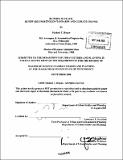Running in place : renewal portfolio standards and climate change
Author(s)
Hogan, Michael T. (Michael Thomas)
DownloadFull printable version (63.89Mb)
Alternative title
RPS and climate change
Other Contributors
Massachusetts Institute of Technology. Dept. of Urban Studies and Planning.
Advisor
Lawrence E. Susskind.
Terms of use
Metadata
Show full item recordAbstract
Renewable portfolio standards ("RPS") have spread widely as states have made an effort to promote electricity production from renewable energy sources, granting privileged market access to eligible technologies and resources. One prominent public policy objective driving their rapid adoption and expansion in recent years has been the desire to mitigate greenhouse gas emissions from the power sector. Eighty percent of power sector CO2, and thus one third of all U.S. CO2, comes from 620 conventional coal-fired power plants. Any one of the range of recent proposals to mitigate U.S. GHG emissions will require dramatic reductions in the CO2 emissions from these plants. This constitutes the essential challenge of power sector GHG policy - in a very real sense, nothing else matters. With this in mind, I have reviewed four state RPS programs - Connecticut, Minnesota, Colorado and California. I offer a thorough analysis of the available data regarding the experience to date in each of these states as well as indications of future compliance activity. My key finding is that the dominant policy approach imposes three key constraints on the RPS market space - targets expressed only in units of bulk energy, aggressive quantities and timelines, and restrictive program cost limits - resulting in the over-stimulation of terrestrial wind at the expense of other renewable technologies often far better suited to displacing coal and far more likely to experience dramatic improvements in cost and performance. In order to enhance the efficacy of these programs as climate policies, the following reforms are recommended: (1) create bands based on technological maturity and strongly favor promising early-stage technologies; (2) express targets in metrics more appropriate to replacing the grid's reliance on coal-fired plants; (cont.) (3); establish compliance guidelines allowing market participants to select higher-cost, early-stage technologies that promise a wider range of services befitting their system requirements; (4) express cost constraints in terms of overall program cost rather than per-unit price caps; (5) skew compliance schedules to smaller quantities from targeted early-stage technologies at the front end, ramping up more rapidly at the back end; and (6) optimize program costs and benefits by allowing some portion of compliance through geographically unrestricted purchase of renewable energy credits, with the balance mandated through purchases from strategic local resources.
Description
Thesis (S.M.)--Massachusetts Institute of Technology, Dept. of Urban Studies and Planning, 2008. Includes bibliographical references (p. 193-213).
Date issued
2008Department
Massachusetts Institute of Technology. Department of Urban Studies and PlanningPublisher
Massachusetts Institute of Technology
Keywords
Urban Studies and Planning.